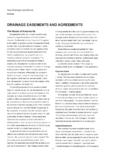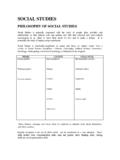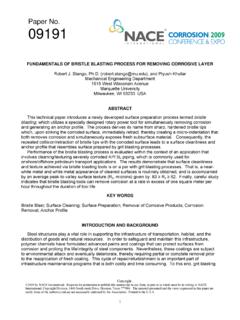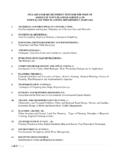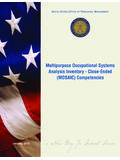Transcription of Traffic Volume Counts
1 PrepareComplete StudySelect LocationDocumentTraffic Volume Counts1. Communicate with other staff/departments2. Review historical data trends3. Review citizen input4. Request Traffic control1. Select the proper location2. Plan the data collection preparations3. Complete the pre-study documentation1. Collect the data2. Evaluate the data1. Finalize the report2. File the report3. Communicate the results3. Calculate the Traffic Volume trends Traffic Volume Counts INTRODUCTIONINTRODUCTION Traffic Volume studies are conducted to determine the number, movements, and classifications of roadway vehicles at a given location.
2 These data can help identify critical flow time periods, determine the influence of large vehicles or pedestrians on vehicular Traffic flow, or document Traffic Volume trends. The length of the sampling period depends on the type of count being taken and the intended use of the data recorded. For example, an intersection count may be conducted during the peak flow period. If so, manual count with 15-minute intervals could be used to obtain the Traffic Volume data. USING COUNT PERIOD TUSING COUNT PERIOD TO DETERMINE STUDY MEO DETERMINE STUDY METHODTHOD Two methods are available for conducting Traffic Volume Counts : (1) manual and (2) automatic.
3 Manual Counts are typically used to gather data for determination of vehicle classification, turning movements, direction of travel, pedestrian movements, or vehicle occupancy. Automatic Counts are typically used to gather data for determination of vehicle hourly patterns, daily or seasonal variations and growth trends, or annual Traffic estimates. The selection of study method should be determined using the count period. The count period should be representative of the time of day, day of month, and month of year for the study area. For example, Counts at a summer resort would not be taken in January.
4 The count period should avoid special event or compromising weather conditions (Sharma 1994). Count periods may range from 5 minutes to 1 year. Typical count periods are 15 minutes or 2 hours for peak periods, 4 hours for morning and afternoon peaks, 6 hours for morning, midday, and afternoon peaks, and 12 hours for daytime periods (Robertson 1994). For example, if you were conducting a 2-hour peak period count, eight 15-minute Counts would be required. The study methods for short duration Counts are described in this chapter in order from least expensive (manual) to most expensive (automatic), assuming the user is starting with no equipment.
5 Traffic Volume Counts (1) MANUAL COUNT MET(1) MANUAL COUNT METHODHOD Most applications of manual Counts require small samples of data at any given location. Manual Counts are sometimes used when the effort and expense of automated equipment are not justified. Manual Counts are necessary when automatic equipment is not available. Manual Counts are typically used for periods of less than a day. Normal intervals for a manual count are 5, 10, or 15 minutes. Traffic Counts during a Monday morning rush hour and a Friday evening rush hour may show exceptionally high volumes and are not normally used in analysis; therefore, Counts are usually conducted on a Tuesday, Wednesday, or Thursday.
6 Manual Count Recording MethodsManual Count Recording Methods Manual Counts are recorded using one of three methods: tally sheets, mechanical counting boards, or electronic counting boards. Tally Sheets Recording data onto tally sheets is the simplest means of conducting manual Counts . The data can be recorded with a tick mark on a pre-prepared field form. A watch or stopwatch is necessary to measure the desired count interval. A blank Traffic Volume count intersection tally sheet is provided in Appendix B. Mechanical Counting Boards Mechanical count boards consist of counters mounted on a board that record each direction of travel.
7 Common Counts include pedestrian, bicycle, vehicle classification, and Traffic Volume Counts . Typical counters are push button devices with three to five registers. Each button represents a different stratification of type of vehicle or pedestrian being counted. The limited number of buttons on the counter can restrict the number of classifications that can be counted on a given board. A watch or a stopwatch is also necessary with this method to measure the desired count interval. See Figure for an example mechanical counting board. Traffic Volume Counts Figure Mechanical Counting Board Electronic Counting Boards Electronic counting boards are battery-operated, hand-held devices used in collecting Traffic count data.
8 They are similar to mechanical counting boards, but with some important differences. Electronic counting boards are lighter, more compact, and easier to handle. They have an internal clock that automatically separates the data by time interval. Special functions include automatic data reduction and summary. The data can also be downloaded to a computer, which saves time. See Figure for an example electronic counting board. Traffic Volume Counts Figure Electronic Counting Board Manual Count Study Preparation ChecklistManual Count Study Preparation Checklist When preparing for a manual count study, use the checklist in Table This checklist may be modified or expanded as necessary.
9 Table Manual Count Study Preparation Checklist Step When Complete Notes Obtain tally sheet or counting board Obtain watch Obtain hardhat and safety vest Select location Select time and day Determine availability of recorders Contact other jurisdictions/schools Contact adjacent residents/businesses Other: If an agency does not possess the equipment necessary to complete a manual count study, it may be obtained from the Iowa DOT, another jurisdiction, or a responsible consulting firm. Traffic Volume Counts Personnel Involved in a Manual Count StudyPersonnel Involved in a Manual Count Study The size of the data collection team depends on the length of the counting period, the type of count being performed, the number of lanes or crosswalks being observed, and the Volume level of Traffic (Robertson 1994).
10 The number of personnel needed also depends on the study data needed. For example, one observer can record certain types of vehicles while another Counts total volumes. Observers conducting manual Traffic Counts must be trained on the study purpose. To avoid fatigue, observers must be relieved periodically. Every 2 hours observers should take a 10 to 15 minute break. Key Steps to a Manual Count StudyKey Steps to a Manual Count Study A manual count study includes three key steps: 1. Perform necessary office preparations. 2. Select proper observer location. 3. Label data sheets and record observations.

